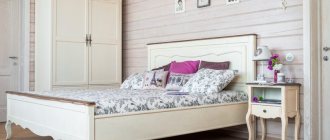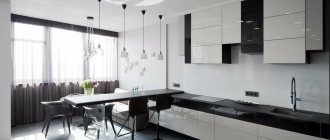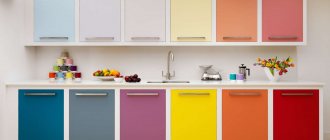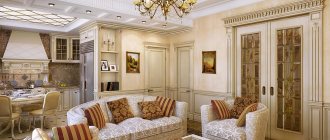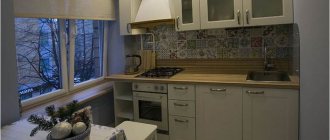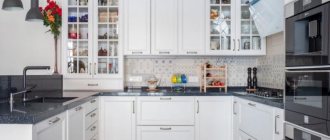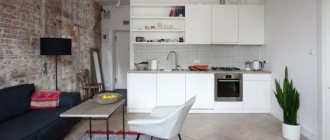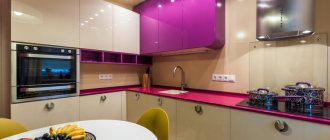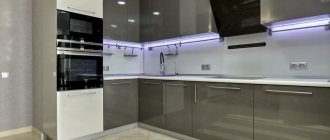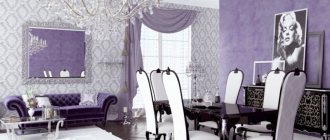Quite a lot of people like the cozy, but at the same time laconic Mediterranean style. It is one of the varieties of the popular Provence style, but it has a number of its own distinctive features, which allows it to be placed in a separate category. The Mediterranean style has absorbed the traditions of several countries at once - France, Italy, Spain, Greece.
Mediterranean style kitchens look very cozy and stylish.
Thus, the freedom of design imagination becomes much wider, and the possibilities for designing a kitchen appear many times more. In this article we will take a detailed look at all the features of the Mediterranean style and give tips on how to make your kitchen truly cozy and beautiful.
The style is very liberal, but it is still worth following the rules.
General design trends
Like any other style, Mediterranean has its own traditions, which should be strictly adhered to. However, it is much freer than the classical types of design, for many of which the rules are unshakable - here you can allow various variations.
Mediterranean-style kitchens can be very diverse.
Let's take a closer look at what features are inherent in the Mediterranean style:
- Most Mediterranean countries adhere to laconicism in the interior. Therefore, you will have to abandon complex, overly elaborate materials and furniture. Give preference to simple lines and textures - with the right combination, they look much more advantageous than complex ones.
- You can compensate for the simplicity with a rich color palette: you are free to use almost any natural shades found in nature and combine them in any way you like. We will tell you more about the colors of a Mediterranean-style kitchen below.
- Finishing materials must be natural or qualitatively imitate natural ones: stone, wood, fabrics, leather, metals. Avoid plastic and lots of glass - they are not typical for the Mediterranean style.
- Remember that the main principle is the combination of beauty with practicality. This means that in such a kitchen there is no place for various decorations that simply take up space: any decor should also have a practical function.
As you can see, nothing is complicated: such rules leave a huge scope for imagination. Now let's move on to more specific recommendations.
The main thing is to find those features that appeal to you.
Tip 8: Pay attention to detail
Mediterranean interior style, like any other, is formed by details. Pay special attention to the decor and try to choose high-quality items, otherwise they will look like cheap props. On the other hand, the Mediterranean interior style implies asceticism in decoration, so you shouldn’t overdo it with the number of accessories either.
- Decor options: wooden clocks, an abundance of indoor plants in clay and wicker pots (the more greenery, the better), thick-walled ceramic dishes, colored glass/ceramic vases, bottles, sachets and bundles of dried herbs, wine stands, wicker baskets.
- In decor and textiles, images of lemons, grapes, olive branches, as well as sea scenes, Greek ornaments and Mediterranean majolica patterns, prints - Vichy check and, of course, blue and white stripes are welcome.
Advice:
- When going on vacation to Greece, Cyprus, Spain and other Mediterranean countries, do not forget to bring souvenirs - sets of oils in bottles, spices in jars, plates painted with majolica and shells with which you can decorate the table as shown in the photo below or make decorative ones with your own hands crafts.
Support the project - share the material with your friends on social networks:
Working with the floor
As we have already said, materials are of great importance - they should be predominantly natural. Most often, tiles or porcelain stoneware are used to finish the floor in the kitchen - they are hygienic, durable and not too expensive.
Sometimes a combined solution is allowed for different zones.
In addition, warm-colored marble is suitable. If a real marble floor seems too expensive for you, you can try to find a suitable imitation. However, the latter must be of high quality - this style does not tolerate outright fakes.
The floor is simply a backdrop to the kitchen, but that doesn’t mean it should be neglected.
Advice! Marble mosaic tiles on the floor are a real boon for a Mediterranean-style kitchen. However, remember that it should not be too pretentious.
A wooden floor also looks good. Choose warm, not too dark shades - the latter may look too heavy.
There are many options for floor design.
The most budget-friendly options can be considered laminate or linoleum - if you choose the right texture, the floor will fit into the interior of your kitchen.
By the way! Warm floors are the ideal solution for a Mediterranean-style kitchen. It will make it much warmer and more comfortable, which is quite consistent with the concept.
Italian style direction
The Italian Mediterranean is characterized by very warm colors. The interior uses orange, light brown tones, and shades of green.
These are the colors used to paint plastered wall surfaces.
Features of rattan chairs and their care- WHERE TO START A KITCHEN REPAIR AND HOW TO FINISH IT
- Blinds for windows. How to choose?
To cover the floor space, natural wood sheets, a bleached plank surface or tiles decorated with ornate prints are laid.
Ceiling finishing
The ceiling occupies a special place in this style. Most often it is decorated with wooden beams - simple or decorative. Think carefully about whether this solution is suitable for your kitchen - in rooms with low walls, the beams will look too heavy, which means they will simply kill it visually.
Ceiling beams look beautiful, but are not suitable for every kitchen.
However: It is not necessary to make the beams massive. Simple thin wooden slats are enough to create an atmosphere. This technique can be used even in the smallest kitchens.
Use plaster as a base - simple or decorative. It is very important to achieve a smooth, evenly painted surface - the appearance of the ceiling largely depends on this. Give preference to light, pastel shades.
Small dark accents are allowed, but the base should be light.
Finishing and design options
It's not difficult to recreate the Mediterranean style yourself in the kitchen. The main thing is to adhere to the features and use natural finishing materials that blend beautifully with the interior.
Flooring
Regardless of the chosen direction of the Mediterranean style, the floor in the kitchen is decorated with wood or stone, porcelain stoneware, tiles, and travertine. When choosing tiles, they prefer matte samples with a rough finish. When choosing wood for the floor, choose aged board samples.
Warm shades of marble are also suitable; if natural marble seems too expensive, choose its imitation. An analogue of natural materials is linoleum or laminate.
Ceiling
A common way to decorate the ceiling in a Mediterranean-style kitchen is with wooden beam structures.
On a note ! Beam structures don't have to be bulky. You can make neat slats from natural wood that are suitable even for the smallest kitchens.
Plaster is used as a basis - ordinary or decorative. It is important that the ceiling surface is straight and evenly painted. Preference is given to neutral tones.
The Greek Mediterranean style is characterized by a flat ceiling in the kitchen, which is obtained using plasterboard painted white. It should be one-level and without unnecessary frills. Only the use of wooden beams is allowed. The Spanish and Italian trends allow the use of stucco.
If there are no beams in the kitchen and you do not want to install them, you can install a suspended ceiling. The panel should be light and matte; glossy surfaces have no place in the Mediterranean style.
Walls
When decorating a kitchen in a Mediterranean style, no wallpaper is used on the walls, with the exception of liquid wallpaper. The coating should be textured; for this purpose, plaster is used and painted white or other light colors.
For the Italian direction, plaster with marble or gypsum particles is suitable. Sometimes Venetian plaster is used, each layer of which is painted with the desired color. A common method of combination is to highlight part of the wall with wooden panels or combine decorative plaster with ceramics. Brickwork is used to highlight the accent wall.
On a note! Mosaic panels are used to decorate the walls in a Mediterranean-style kitchen. When using ceramic tiles, choose samples with an imitation of antiquity.
Apron
The apron plays a major role in a Mediterranean-style kitchen. The standard way of finishing it is ceramics or mosaics with frescoes, thematic designs, and ornaments. Often preference is given to geometry, vegetation and ethnicity.
Stylish design - finished with aged tiles. You can decorate the apron with marble mosaics or tiles with hand-painted Greek and Italian majolica.
Wall decoration in the kitchen
If the ceiling should be perfectly flat, the walls, on the contrary, should be made rough and textured. This combination will make your kitchen interesting and attractive, filling it with comfort.
However, a lot depends on which direction of the Mediterranean style you prefer. For example, relief in the Greek version is achieved through the choice of finishing materials - liquid wallpaper, plaster, paint. In this case, it is important to choose the right type of coating - for example, textured decorative bark beetle plaster or curly panels.
It is important to pay attention to the topography of the kitchen.
For Italian and Spanish styles, the use of a combination of different types of materials is closer. For example, plasters with wallpaper or wood panels. You can safely combine even three or four types of coating - the Mediterranean style allows such experiments. However, the transition should be smooth - different materials that are similar in tone look best.
Don’t be afraid to combine materials of different colors and textures.
Tip 3. We give preference to natural finishing materials or high-quality imitations
- For wall decoration, it is preferable to use: decorative plaster, brickwork (or very high-quality imitation), textured plain wallpaper or paintable wallpaper. Walls in the Greek style are most often white, in Spanish - beige, olive, orange, etc.
- In floor finishing: porcelain tiles imitating stone, for example, travertine, ceramic tiles also imitating stone or unpainted clay, as well as wooden parquet boards, natural wood, laminate.
Adviсe:
- It is desirable that the wood on the floor appears bleached and worn;
- Stone, porcelain stoneware and tiles should be insulated with a heating system, because while in hot countries these materials provide pleasant coolness, in northern latitudes they only bring discomfort.
- The following materials are suitable for finishing the ceiling: plaster, matte paint, suspended matte ceiling, ceiling made of wooden lining. For high ceilings, decorative beams as in the photo below are appropriate as an addition.
Apron
The walls, floor and ceiling in such a kitchen are more like edging. The main design role is given to the apron, so it must be finished with all possible care.
The classic choice is a neat mosaic backsplash.
The most traditional option for a backsplash is ceramic tiles or mosaics. Don’t be afraid to use frescoes, tiles, and various ornaments. Unusual color combinations, various patterns - and such an apron will become a real decoration of your kitchen.
However, classic tiles may be appropriate.
However, avoid being too fussy as it can cause damage. It is better to give preference to geometric, floral or ethnic motifs. They will always be appropriate and will not overload your kitchen.
A fashionable technique is the use of specially aged tiles. Scuffs and roughness will add charm to the room. However, remember that simply old materials will not work - the antique effect looks good only if it is achieved on purpose.
Retro tiles are an excellent choice.
Furniture
It is very important to choose the right pieces of furniture - otherwise all efforts to create a characteristic finish may be in vain. For Mediterranean interiors, we recommend choosing massive furniture made of natural wood. However, some elements may be metal. But it is better to avoid glass, plastic and other modern materials - they are not very suitable for this design.
Massive pieces of furniture are a must-have.
will suit you:
- Wooden sideboards with open shelves. The Mediterranean style is characterized by a large amount of open space, so it is better to avoid closed cabinets, at least in the upper part of the set.
- Wicker or forged chairs. Here you can move away from the overall massiveness - against the backdrop of bulky furniture, elegant chairs look very advantageous.
- Massive tables made of wood, round or rectangular.
- A wide variety of shelves on which you can place all the necessary kitchen utensils.
Special attention should be paid to the tabletop. It can be either simply stone or with an unusual mosaic pattern. The last option looks very attractive, but you need to understand that the design of the tabletop should be combined with the apron. Otherwise you'll end up with ridiculous kitsch.
You can smooth out the massiveness with color.
It is better to select household appliances in light colors, but if you wish, you can decorate them at your discretion. Decoupage, painting, various types of designs - all this will decorate your kitchen, making it more comfortable. However, in this case it is extremely important not to overdo it - the patterns should be light and airy.
You need to be careful when fitting appliances into the interior of such a kitchen.
Set
Original furniture made of bleached wood, roughly painted on top, blue or blue paint, forged parts, wicker elements - all this, along with a fair amount of asceticism, symbolizes Greece.
But for Italy and Spain, softer wood processing is closer. Even carving is allowed, but not complicated.
The modern Mediterranean style welcomes such deviations from traditional design as the presence of glass and metal surfaces, as well as chrome and gloss finishes.
Color selection
This type of design welcomes the use of a wide variety of shades of a natural, natural palette - from delicate pastels to rich, catchy ones. There are two types of color schemes.
It is important to find the right color solution.
Monochrome design is typical for Mediterranean-style kitchens, made in the spirit of Spain or Italy. Smooth transitions of tones, warm tones... In this case, it is better to focus on light shades - beige, yellow, soft light green, white, coral. However, no one forbids adding two or three bright shades - for example, blue, burgundy or terracotta. It is better to place strokes of color on the apron or in decorative elements - this way the room will look more organic.
A colorful accent will brighten up your kitchen.
The basis of the contrasting design is white. This design is typical of the Greek style. At the same time, white can harmonize with almost any shade, except, perhaps, glossy metallic and various acid tones. Combine it with blue, red, yellow, green colors - it all depends on your preferences.
Dilute matching shades with accents.
What type of color scheme should I choose? You decide. Both have their fans and opponents. However, let us draw your attention to the fact that monochrome design is more suitable for small spaces - due to the abundance of light colors, it visually makes a small kitchen larger.
Don't be afraid to experiment.
Choosing lighting
In the classical sense, a Mediterranean-style kitchen should be filled with light. If during the daytime this is facilitated by natural lighting, then you will have to take care of artificial lighting yourself.
Lighting is an important aspect of a Mediterranean-style kitchen.
First of all, give preference to lamps of the natural light segment - warm shades are much better than modern cold ones, which are not suitable for this type of interior. Plus, they're better for your eyes.
Hang a beautiful small chandelier or sconce above your dining table. It could be a classic lamp, a lamp in Provence or country style, an unusual hand-made lampshade - here your imagination is practically unlimited.
In the work area you can also use various types of sconces or, on the contrary, limit yourself to spotlights. It would not be a bad idea to install lighting on the furniture - for example, along the bottom line of the upper cabinets. This will make your work more comfortable and is fully consistent with the “More Light!” concept.
Main features of the interior of Mediterranean cuisine
The Mediterranean style is dominated by lightness, grace and originality, which is achieved by light colors, general asceticism of the decor and a unique combination of materials.
Mediterranean motifs are reflected in the proximity to marine themes, pure, natural colors and natural materials.
The key features of the Mediterranean interior should be noted:
- ceramic tiles with tiles and majolica as an apron for the work area;
- laconic furniture made of light or bleached wood;
- wicker furniture and accessories;
- forged metal elements as functional and decorative parts;
- lack of hanging shelves;
- textured treatment of walls: brick or stone masonry, plaster, embossed wallpaper, paint;
- monochromatic interior design with a predominance of pure bright colors (blue, orange, olive) with white;
- natural wood is used for the floor; in a modern style, laminate and ceramics are allowed, including those with elegant patterns;
- the use of textiles made from natural materials, such as linen or cotton;
- lampshades and original lamps.
Rich natural colors, an abundance of light and bright accents in a simple and practical setting are the main ideas for decorating a room in the style of Mediterranean countries.
Important! Today, the Mediterranean style allows a combination of wood, rattan with glass and chrome, as well as other modern materials.
For all Mediterranean countries, the kitchen is the central room in the entire house.
We focus on textiles
The main role in decorating a kitchen in a Mediterranean style lies with textiles. You need to carefully select curtains, tablecloths, napkins and other fabric items needed in the kitchen. In addition, you can sew special covers for chairs or put small cushions on the seats - all this will be quite appropriate.
Even small textile elements will decorate the kitchen.
It is only important that all the elements are combined with each other - perhaps it makes sense to think about making custom textiles.
Kitchen textiles should be made from bleached and unbleached linen, cotton and chintz. All materials must be of the highest quality. As for decoration, you can decorate textiles with patterns, embroidery, ornaments, images with plant or ethnic motifs.
You can replace textiles with rattan - if for some reason you don’t like the fabric.
It would be a good idea to put a couple of small rugs in the kitchen. This is especially true if there are children in the house - it will be much more comfortable for them to be in the kitchen.
A small rug will add coziness to the kitchen.
As for curtains, you should choose light, flowing tulle or give preference to simple cotton curtains. The rules here are the same as for kitchen textiles - high-quality fabrics and unobtrusive patterns in natural colors.
Decorate your kitchen with bright curtains.
If fabric curtains aren't your thing, consider bamboo blinds or roller blinds - they're also fine.
Choosing decor
There should not be too much decoration in a Mediterranean-style kitchen. Pay attention to quality, not quantity: all decorative elements should be expensive, durable and, preferably, functional.
The decor should be laconic.
You can use various beautiful dishes, decorative flower pots, and plants. Small flowerpots with spices, miniature peppers or tomatoes look good - both beautiful and tasty.
Everything must fit together.
Hanging bunches of dried herbs or flowers look interesting - if desired, they can also be used in cooking.
We are sure that with our tips you can easily create a beautiful Mediterranean-style kitchen!
[author_bq]
Photo gallery – Mediterranean style kitchen
Modern interiors in the southern style look not only fashionable and beautiful, but also reminiscent of sunny countries on the Mediterranean coast. Each country has its own, unique design style, which can be repeated with your own hands.
A light, elegant and functional interior will be a godsend for updating your kitchen renovation.
Create a bright atmosphere of Italy, Greece and Spain in your kitchen so that the southern sun can be with you at any time of the year.
Practical tips will help you design your interior as authentic, original and modern as possible.
